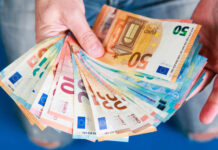In focus today
In the US, the focus will be on April CPI. We forecast headline inflation at +0.4% m/m SA, as energy inflation has been boosted by rising oil prices. Core inflation is likely to tick slightly lower to 0.3% m/m SA, driven especially by further disinflation in housing services. Recently, leading data has painted a mixed picture, with PPI and ISM pointing towards accelerating inflation, while PMIs and NFIB neglect this notion.
In the euro area, industrial production data for March and employment growth for Q1 are scheduled for release. The current strong labour market gives upside risks to wage growth and thereby domestic inflation.
In Sweden, today is all about inflation. We expect the April figures to continue printing well below the Riksbank’s current inflation forecast. Hence, we see both CPIF and CPIF excl. energy being 0.4 p.p. below the Riksbank, at 2.3% y/y and 2.9% y/y.
Overnight, the first estimate of the Japanese Q1 national accounts are to be released. Stagnation will likely remain the headline as both spending and export data has been to the weak side.
Economic and market news
What happened overnight
In China, PBOC left the medium-term lending facility rate unchanged at 2.5%, as widely expected. This underscores the notion that China is likely waiting for the Fed to ease before cutting rates further.
Japanese equities were higher this morning – strongly fuelled by Sony. The Japanese firm saw its shares surging 12% in early trading after the company’s robust earnings report, a stock split, and a share buyback of approximately USD 1.6 billion. Additionally, Sony raised its outlook.
What happened yesterday
In the US, PPI was higher than expected in April, with the final demand excl. food and energy measure at 0.5% m/m (cons: 0.2%). The uptick was driven primarily by strong gains in costs of services. Notably, the March figure was revised down to -0.1% from 0.2%. Although the report was hotter than expected, Fed Chair Powell described it as more “mixed” than “hot” as prior data was revised lower. Moreover, Powell stated while he expects inflation to move back down, his confidence has waned, indicating that the Fed is likely to hold the policy rate where it is.
The NFIB small business sentiment recovered somewhat in April, coming in at 89.7 (prior: 88.5). Interestingly, there was a notable downtick in companies’ 3m price plans, reaching the lowest level since last April. Additionally, some companies continued to report labour shortages, but overall hiring plans remain below pre-pandemic levels.
On the political front, the Biden administration officially unveiled steep tariffs on a range of imports from China, including EVs and solar cells. The White House announced that USD 18 billion worth of Chinese goods would be affected by the increases, which are carefully targeted at strategic sectors to protect American jobs ahead of the US election. Starting this year, among many rates, tariffs on Chinese imported EVs will be quadrupled from 25% to 100%. Additionally, the tariff on Chinese chips will be doubled starting in 2025.
In the UK, the labour market report for March/April indicated that the labour market is still tight but remains well in line with forecasts from the BoE. The unemployment rate in March was 4.3%, up from 4.2% (BoE forecast: 4.3%). Wage growth excl. bonus stood unchanged at 6.0% 3m y/y (cons: 5.9%). That said, the private sector is key as stressed by the BoE. Private sector wage growth was 5.9% 3m y/y for March, fairly in line with BoE’s forecast of 6.0%, while the momentum dampened slightly to 0.6% m/m. The vacancies-to-unemployment ratio is now back at 2019 average. Overall, in our view the data batch supports the notion of a June cut.
In Germany, the ZEW survey was released. Assessment of the current economic situation rose to -72.3 (cons: -75.9, prior: -79.2), marking the largest increase in more than a year, while the expectations component climbed to 47.1 (cons: 46.4, prior: 42.9). Coupled with PMI above 50 and high-frequency indicators moving up, this could signal that the worst is over in the German economy. Thus, we expect the economy to grow throughout the year but at a modest pace as the manufacturing sector is still struggling.
In the commodity space, OPEC’s forecast for global oil demand in 2024 remains unchanged from last month, with expectations of an increase by 2.25 million bpd in 2024 and 1.85 million bpd in 2025. The cartel also announced a shift in focus to towards projected demand for OPEC+ crude, indicating that the broader group is now the primary forum for market cooperation. The report was the final one before OPEC+ convenes on 1 June, where the extension of voluntary oil output cuts into the second half 2024 will be discussed. Brent crude fell roughly 1.20% during yesterday’s trading session.
Market movements
Equities: Global equities were higher yesterday lifted by the US, cyclicals, growth and small cap stocks. It was yet another quiet low volume session where indices ended close to day-high as bond yields ended close to day-low. There were many stories about meme stock frenzy taking off again, which is partly a story of exuberance but also a story of very few other talking points. In the US yesterday, Dow +0.3%, S&P 500 +0.5%, Nasdaq +0.8%, Russell 2000 +1.1%. Asian markets are mostly lower this morning while both European and US futures are higher.
FI: The general theme in yesterday’s trading session was a gradual drift higher for yields, in what can best be described as a parallel shift of the curves. While the knee-jerk reaction to the stronger than expected US PPI in the afternoon sent yields a couple of bp higher, it was however quickly reversed. The sell-off theme got renewed strength following hawkish messages from Powell and Knot. Knot was accompanied by Wunsch in their call for not doing a July cut after the June cut. Markets are pricing 68bp of ECB rate cuts by year end, which is 3bp less than yesterday. 10y Bunds ended 4bp higher at 2.55%.
FX: EUR/USD has consolidated above the 1.08 mark. USD/JPY stabilised above 156. EUR/SEK and EUR/NOK are hovering just below 11.70. EUR/GBP ended the day broadly unchanged after the labour market report for March/April delivered a mixed bag of news and the Bo’’s Pill delivered a speech with a dovish twist.













